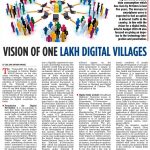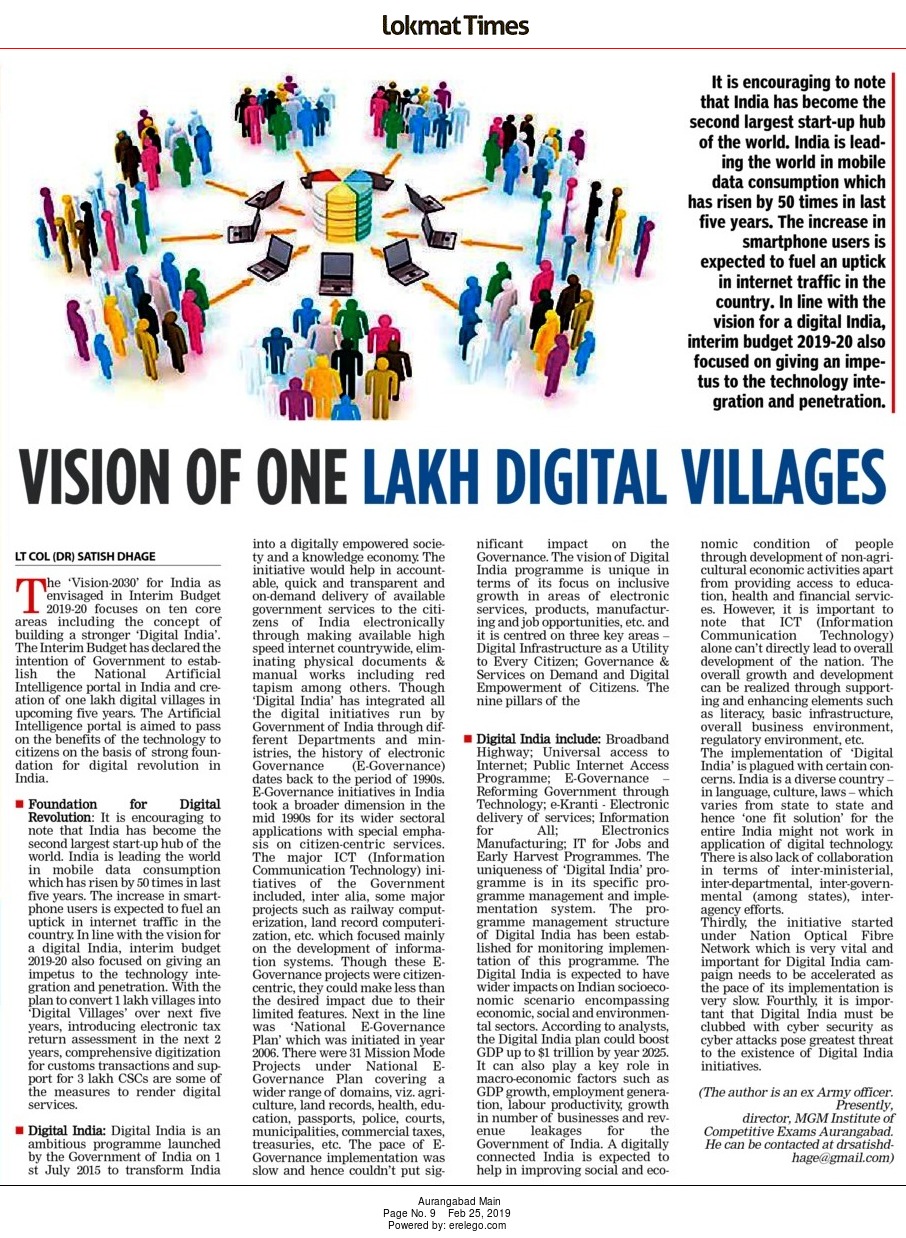Vision of one lakh digital villages
The ‘Vision-2030’ for India as envisaged in Interim Budget 2019-20 focuses on ten core areas including the concept of building a stronger ‘Digital India’. The Interim Budget has declared the intention of Government to establish the National Artificial Intelligence portal in India and creation of one lakh digital villages in upcoming five years. The Artificial Intelligence portal is aimed to pass on the benefits of the technology to citizens on the basis of strong foundation for digital revolution in India. Foundation for Digital Revolution– It is encouraging to note that India has become the second largest start-up hub of the world. India is leading the world in mobile data consumption which has risen by 50 times in last five years. The increase in smartphone users is expected to fuel an uptick in internet traffic in the country. In line with the vision for a digital India, interim budget 2019-20 also focused on giving an impetus to the technology integration and penetration. With the plan to convert 1 lakh villages into ‘Digital Villages’ over next five years, introducing electronic tax return assessment in the next 2 years, comprehensive digitization for customs transactions and support for 3 lakh CSCs are some of the measures to render digital services. Digital India- Digital India is an ambitious programme launched by the Government of India on 1st July 2015 to transform India into a digitally empowered society and a knowledge economy. The initiative would help in accountable, quick and transparent and on-demand delivery of available government services to the citizens of India electronically through making available high-speed internet countrywide, eliminating physical documents & manual works including red tapism among others. Though ‘Digital India’ has integrated all the digital initiatives run by Government of India through different Departments and ministries, the history of electronic Governance (E-Governance) dates back to the period of the 1990s. E-Governance initiatives in India took a broader dimension in the mid-1990s for its wider sectoral applications with special emphasis on citizen-centric services. The major ICT (Information Communication Technology) initiatives of the Government included, inter alia, some major projects such as railway computerization, land record computerization, etc. which focused mainly on the development of information systems. Though these E-Governance projects were citizen-centric, they could make less than the desired impact due to their limited features. Next in the line was ‘National E-Governance Plan’ which was initiated in the year 2006. There were 31 Mission Mode Projects under National E-Governance Plan covering a wider range of domains, viz. agriculture, land records, health, education, passports, police, courts, municipalities, commercial taxes, treasuries, etc. The pace of E- Governance implementation was slow and hence couldn’t put a significant impact on the Governance. The vision of Digital India programme is unique in terms of its focus on inclusive growth in areas of electronic services, products, manufacturing and job opportunities, etc. and it is centred on three key areas – Digital Infrastructure as a Utility to Every Citizen; Governance & Services on Demand and Digital Empowerment of Citizens. The nine pillars of the Digital India include- Broadband Highway; Universal access to Internet; Public Internet Access Programme; E-Governance – Reforming Government through Technology; e-Kranti – Electronic delivery of services; Information for All; Electronics Manufacturing; IT for Jobs and Early Harvest Programmes. The uniqueness of ‘Digital India’ programme is in its specific programme management and implementation system. The programme management structure of Digital India has been established for monitoring implementation of this programme. The Digital India is expected to have wider impacts on Indian socioeconomic scenario encompassing economic, social and environmental sectors. According to analysts, the Digital India plan could boost GDP up to $1 trillion by year 2025. It can also play a key role in macro-economic factors such as GDP growth, employment generation, labour productivity, growth in number of businesses and revenue leakages for the Government of India. A digitally connected India is expected to help in improving social and economic condition of people through development of non-agricultural economic activities apart from providing access to education, health and financial services. However, it is important to note that ICT (Information Communication Technology) alone can’t directly lead to overall development of the nation. The overall growth and development can be realized through supporting and enhancing elements such as literacy, basic infrastructure, overall business environment, regulatory environment, etc. The implementation of ‘Digital India’ is plagued with certain concerns. India is a diverse country – in language, culture, laws – which varies from state to state and hence ‘one fit solution’ for the entire India might not work in application of digital technology. There is also lack of collaboration in terms of inter-ministerial, inter-departmental, inter-governmental (among states), inter-agency efforts. Thirdly, the initiative started under Nation Optical Fibre Network which is very vital and important for Digital India campaign needs to be accelerated as the pace of its implementation is very slow. Fourthly, it is important that Digital India must be clubbed with cyber security as cyber attacks pose greatest threat to the existence of Digital India initiatives. (The author of this article ,Lt Col (Dr) Satish Dhage, is an ex Army officer and has been qualified for IPS (Indian Police Services) through IPS LCE 2012. Presently, he is Director, MGM Institute of Competitive Exams Aurangabad. For any queries or feedback, he can be contacted on email id : drsatishdhage@gmail.com)




